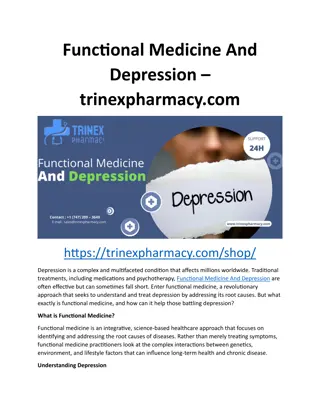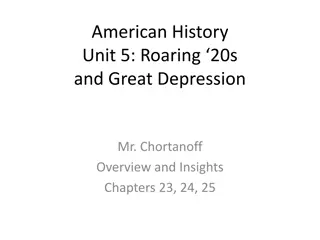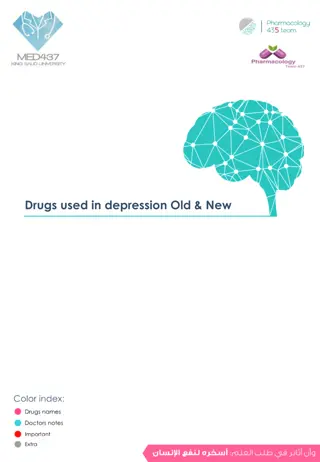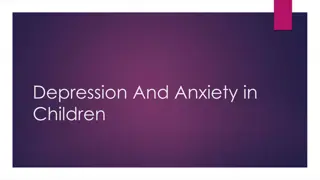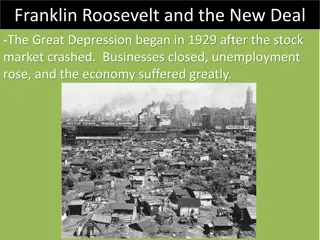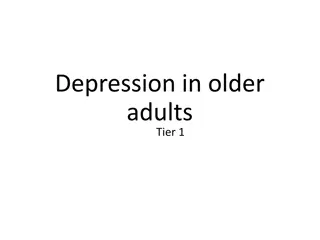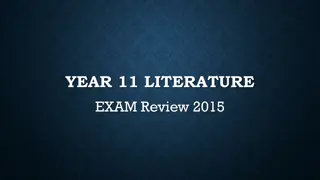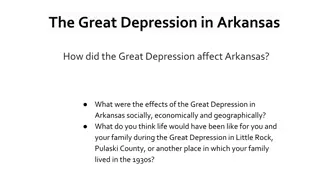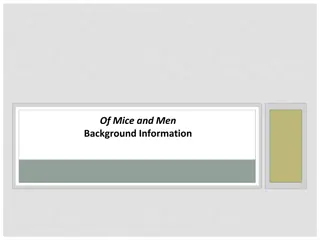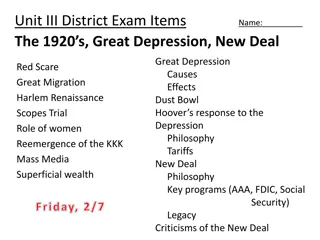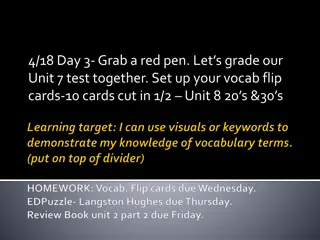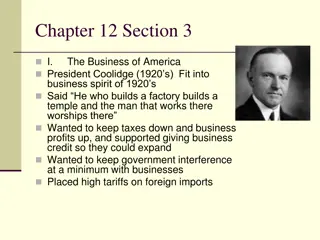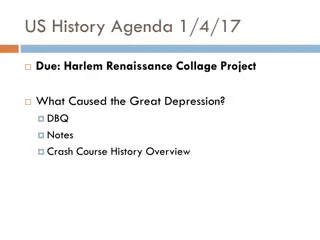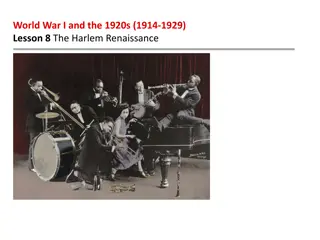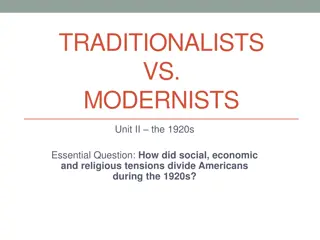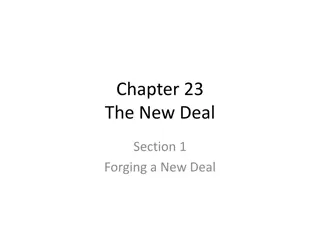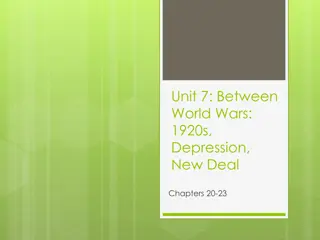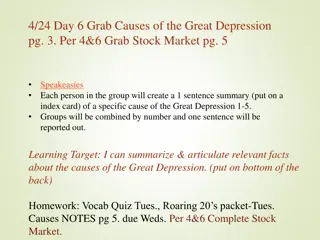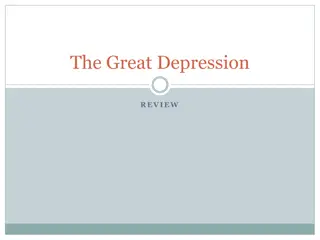Roaring 1920s, Great Depression & New Deal Overview
Delve into the transformative period of the Roaring 1920s, the devastating impact of the Great Depression, and the consequential implementation of the New Deal in American history. Explore various chapters discussing postwar tensions, social trends, economic collapse, and government responses during this tumultuous era.
Download Presentation

Please find below an Image/Link to download the presentation.
The content on the website is provided AS IS for your information and personal use only. It may not be sold, licensed, or shared on other websites without obtaining consent from the author.If you encounter any issues during the download, it is possible that the publisher has removed the file from their server.
You are allowed to download the files provided on this website for personal or commercial use, subject to the condition that they are used lawfully. All files are the property of their respective owners.
The content on the website is provided AS IS for your information and personal use only. It may not be sold, licensed, or shared on other websites without obtaining consent from the author.
E N D
Presentation Transcript
Socratic Circle #2 Unit III: Roaring 1920s, Great Depression, & New Deal December 2014 The Americans Chapters 12-15 History Alive! Chapters 26-33
Unit III: 1920s, Great Depression & New Deal Socratic Circle Preparations Wednesday, 12/3 & Friday, 12/5 1) After logging in & opening ROBINSON Shares file, designate a chapter captain who will SAVE the file to her/his network folder. period#lastnamechapter# Sample File name: 2Johnson12 2) Examine Robinson s outline PPT as a group, then decide which questions (slides) to keep, edit, or delete. *Each student is responsible for one question related to your assigned chapter. An opening slide for the group is required (names, period, date, images.) 3) Use flash drives, network folders, or Office 365 to SAVE & SHARE your contributions as you assemble a chapter-specific PowerPoint slide show containing: ONE SLIDE per PERSON* ex. Group of 5 people = 6 slides (intro slide, plus 5 question slides) filled with ONE open-ended discussion question illustrative & appropriate pictures, clip art, graphs, maps, sound and/or video clips, etc. use PowerPoint tricks to FILL slide (entrance, exit, emphasis, etc. animation) * Include your name on your slide and plan on facilitating a Socratic circle conversation (anticipate answers & follow up ?s) *Use time wisely & make good choices as you select/write questions, create and arrange your slides into Johnson s file!
http://student.teachtci.com/student/sign_in History Alive! mrobinso@cbsd.org Lenape Log-in Password: history Era 4, p. 326-327: The Roaring Twenties and the Great Depression Unit 8: The Twenties (p. 328-380) Ch. 26 Understanding Postwar Tensions (p. 330-341) Ch. 27 The Politics of Normalcy (p. 342-351) Ch. 28 Popular Culture in the Roaring Twenties (p. 353-367) Ch. 29 Clash Between Traditionalism & Modernism (p. 369-379) Unit 9: The Great Depression and the New Deal (p. 381-427) Ch. 30 The Causes of the Great Depression (p. 382-391) Ch. 31 The Response to the Economic Collapse (p. 392-399) Ch. 32 The Human Impact of the Great Depression (p. 400-411) Ch. 33 The New Deal and its Legacy (p. 412-427)
History Alive! Ch. 26-29 Unit 8: The Twenties (p. 328-380) What effects did postwar tensions have on America s ideals? Did the Republican Era of the 1920s bring peace and prosperity to all Americans? What social trends and innovations shaped popular culture during the 1920s? How did social, economic, and religious tensions divide Americans during the Roaring Twenties?
History Alive! Ch. 30-33 Unit 9: The Great Depression and the New Deal (p. 381-427) What caused the most severe economic crisis in American history? How did the federal government respond to the economic collapse the began in 1929? How did ordinary Americans endure the hardships of the Great Depression? How did expansion of the government during the New Deal affect the nation?
www.tinyurl.com/lenapelibrary click on Research Databases ABC-Clio American History database click on Eras at the top Roaring Twenties, Depression, and New Deal click on one of the topics Overview page expand it to additional articles on the left Gale Student Resources is also an awesome database for history. -librarian
Unit III: 1920s, Great Depression & New Deal Socratic Circle Preparations made for Chapter 12: The Politics of the Roaring Twenties (p. 410-431) By: INSERT your names & Period #
Unit III: 1920s, Great Depression & New Deal Socratic Circle Preparations made for Chapter 13: The Roaring Life of the 1920s (p. 432-461) By: INSERT your names & Period #
Unit III: 1920s, Great Depression & New Deal Socratic Circle Preparations made for Chapter 14: The Great Depression Begins (p. 462-485) By: INSERT your names & Period #
Unit III: 1920s, Great Depression & New Deal Socratic Circle Preparations made for Chapter 15: The New Deal (p. 486-523) By: INSERT your names & Period #
Ch. 12: The Politics of the 1920s Warren G. Harding s presidency was plagued by scandal, and it was later regarded as unsuccessful. Explain why President Harding was popular with the American public despite these facts. Think About: American attitudes and feelings after World War I Harding s appearance, personality, and promises the yearning for the simpler days before the Progressive Era and World War I What technological invention or advancement of the 1920s had the biggest impact on the life of the average American? Explain your opinion. Think About: advances in the fields of business, transportation, power, and machinery the basic needs of Americans the conveniences offered by new technology
Ch. 12: The Politics of the 1920s What was the quota system of the 1920s? Explain why it was established, who it affected, and several results of the policy. Think About: nativism immigration rates relations with foreign countries Why were advertisements so successful in the 1920s? Do they serve the same purpose today? Explain your answer. Think About: the needs and desires of the American public the goals of advertising
Ch. 12: The Politics of the 1920s Why did the Ku Klux Klan flourish in the 1920s? What does this tell you about people s behavior in troublesome times? Think About: the fears and concerns of Americans after World War I the beliefs and practices of the Ku Klux Klan the various cultures that make up American society Although the 1920s were prosperous years for the United States, why is this prosperity considered superficial? Can you see any similarities between the United States in the 1920s and today? Think About: technological advances Americans spending habits income gaps between various kinds of workers
What are some of the reasons that membership in labor unions dropped during the 1920s? How would you describe the years of the Harding presidency? Why would you describe them that way? How would you describe the years of the Harding presidency? Why would you describe them that way? What signs existed in the 1920s suggesting that economic prosperity might be superficial?
Ch. 13: Roaring Life of the 1920s How did the lives of women change during the 1920s? Think About: social attitudes fashion work opportunities home life What can you conclude from the fact that prohibition failed to meet its goals? Identify and support at least three conclusions. Think About: reasons for the legislation results of the legislation enforcement of the law
Ch. 13: Roaring Life of the 1920s Describe one way U.S. society or culture has changed significantly from the 1920s to today and one way it has not. Think About: women s roles in the home and workplace racial relations entertainment and socializing Consider the Great Migration and the Harlem Renaissance and their consequences. Describe the effects that these events had on the country. Think About: the National Association for the Advancement of Colored People the impact these events had on cities, art, literature, and music the Universal Negro Improvement Association
Ch. 13: Roaring Life of the 1920s Describe one factor that you think worked to divide America and one factor that worked to unify America in the 1920s. Explain your choices. Think About: popular culture and mass media changes in literary culture fundamentalism and science urban and rural lifestyles The 1920s was a time of change in the literary world. Many modern American writers were expatriated, while many others were at home contributing to the Harlem Renaissance. Compare and contrast common themes in the works of Harlem Renaissance writers and in the writing of the expatriates. Think About: the perspectives of the authors the personal experiences of the authors the cultural and social climate of the time
Explain how prohibition came to be viewed as a problem rather than a solution. In what ways did the image of the flapper reflect real social change and in what ways did it fail to reflect reality? What roles did education and the mass media play in creating an American popular culture? Compare the views of W. E. B. Du Bois and Marcus Garvey toward racial inequality and its solutions.
Ch. 14: The Great Depression Begins In what ways was the economic prosperity of the 1920s genuine, and in what ways did this prosperity disguise serious economic problems? Do you think most people perceived the underlying problems in the economy? Why or why not? Think About: the performance of the stock market the availability of consumer goods people s spending patterns influences on public opinion Describe some of the psychological effects, both negative and positive, of the Great Depression. How do you think you would have survived the hardships that were widespread during this period? Think About: people s feelings in response to unemployment and other deprivations the ways in which people adjusted to hardships people s behavior toward others
Ch. 14: The Great Depression Begins Explain how the economy went from apparent prosperity to a severe depression between 1929 and 1932. What brought about this dramatic change? Who and what was affected? Think About: the stock market the situation of farmers banks and businesses personal income and debt Evaluate President Hoover s success in dealing with the Great Depression. Were his actions as president effective? How did the public perceive his actions? Think About: Hoover s guiding beliefs changes in Hoover s economic policy over time Hoover s response to the Bonus Army
Ch. 14: The Great Depression Begins Describe one factor that you think worked to divide America and one factor that worked to unify America in the 1920s. Explain your choices. Think About: popular culture and mass media changes in literary culture fundamentalism and science urban and rural lifestyles The 1920s was a time of change in the literary world. Many modern American writers were expatriated, while many others were at home contributing to the Harlem Renaissance. Compare and contrast common themes in the works of Harlem Renaissance writers and in the writing of the expatriates. Think About: the perspectives of the authors the personal experiences of the authors the cultural and social climate of the time
Describe the fundamental problems in one of the following areas of the economy and how they helped to cause the Great Depression: industry, agriculture, consumer spending and debt, distribution of wealth. Identify some of the physical and emotional health problems caused by the Great Depression. Compare President Hoover s response to the stock market crash of 1929 to his response to the Great Depression in the early 1930s.
Ch. 15: The New Deal Why was Franklin D. Roosevelt able to quickly instill confidence in the federal government s ability to end the Depression? Give two reasons. Think About: Roosevelt s personality and interactions with the American public the goals and effects of early New Deal policies What were the goals of President Roosevelt s fireside chats ? How did he achieve his goals? Think About: the medium of communication Roosevelt chose the style of language Roosevelt used
Ch. 15: The New Deal What unique problems did farmers and other people living in rural areas face during the Depression? How did the New Deal address those problems? Think About: the Agricultural Adjustment Act the Tennessee Valley Authority the Rural Electrification Administration What role did the arts play in America in the 1930s? How did the Roosevelt administration support the arts? Think About: visual arts and the Great Depression leisure activities of Americans special branches of the WPA
Ch. 15: The New Deal Describe the effects of New Deal public works projects on the economy, the environment, and people s personal lives. Think About: the lives of unemployed Americans before the New Deal the accomplishments of the CCC, TVA, and WPA the difference between receiving charity and being offered a job What are some of the lasting effects of the New Deal on banking and finance in the United States? Think About: the factors that led to the Great Depression the Federal Deposit Insurance Corporation (FDIC) the Securities and Exchange Commission (SEC)
Identify one objection that each of the following had to parts or all of the New Deal: conservative groups such as the American Liberty League, liberals such as Huey Long, and the Supreme Court. Why was Eleanor Roosevelt interested in the New Deal, and what role did she play in it? Identify two groups that were part of the New Deal Coalition. What reasons did these groups have for supporting the Roosevelt administration and its New Deal? Why do you think that movies and radio became as popular as they did during the 1930s? Give at least two reasons. Identify some conservative and liberal criticisms of the New Deal and its legacy.


